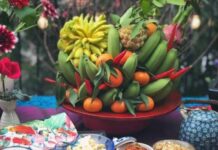Cassia Fistula: An Ornamental Shade Tree
The Cassia Fistula, commonly known as the Golden Shower Tree, is a popular choice for gardening and landscaping in Asian countries. With its vibrant display of flowers and lush foliage, this tree offers both aesthetic appeal and a comfortable shade.
Mature Cassia Fistula trees typically reach heights of 4-10 meters, though they can grow taller, up to 15 meters, if properly cared for. They have a medium-sized trunk and a dense canopy. The tree’s showy flowers range from yellow-orange to pale yellow, emitting a subtle yet captivating fragrance. Blooming usually occurs around early October, and with the right care, the tree can flower throughout the year.
The fruits of the Cassia Fistula are unique, with a purplish-black color and a host of seeds inside. It takes about half a year from the time of fruit set for the fruits to fully ripen.
Propagation Methods

Cassia Fistula can be propagated through stem cuttings or air layering.
– Stem Cutting Propagation
Select healthy stems from a mature Cassia Fistula tree, approximately 10-15 cm in length, with young, developing leaves. Using a sharp pair of shears, cut the stem from the mother plant and dip the cut end into a rooting hormone to encourage root development.
Prepare a potting mix and make a small hole in the center. Place the cutting into the hole and firmly pack the soil around it. Regular watering is essential to help the cutting develop roots.
After about a month, the cutting should have grown into a healthy young plant. Continue to care for it, and if desired, you can keep it potted and regularly prune it to maintain a compact size. Alternatively, you can transplant it into the ground if you wish to grow it into a large shade tree.
– Air Layering Propagation
Choose a young, developing stem for air layering. Avoid stems with insect infestations or those hidden under the canopy, as they may have limited access to sunlight and poor photosynthetic capacity.
Select an area on the stem free of buds or eyes and make a clean cut with a sharp knife. Remove a section of the bark about 5-10 cm wide. Prepare a ball of moist soil and secure it around the exposed stem with plastic wrap and string. Poke a few holes in the plastic to allow excess moisture to escape.
Maintain moisture in the soil ball and, after about a month, you should see new roots forming. In another month or so, you can sever the rooted stem from the mother plant and pot it separately.
Care Instructions for Cassia Fistula

Cassia Fistula thrives in sunny locations.
The Cassia Fistula thrives in sunny locations and requires ample sunlight to produce abundant foliage and flowers. Planting it in shaded areas will hinder its growth and flowering potential.
This tree prefers moist conditions, so regular watering is essential, especially during the early morning or late afternoon. Avoid watering during the hottest part of the day, and be careful not to overwater, as this may lead to root rot.
To provide additional nutrients, organic or NPK fertilizer can be applied around the base of the tree and watered in. When the tree is in its flowering phase, consider using a fertilizer high in potassium to prolong the blooming period and enhance the beauty of the flowers.
Cassia Fistula trees are prone to insect infestations, so regular inspections for pests and diseases are crucial. If any issues are spotted, appropriate pesticides can be applied to protect the tree.
For larger, more established trees, pruning can be performed to maintain a neat appearance and encourage flowering. By selectively removing excess branches, you can direct the tree’s energy towards producing more flowers and maintaining a compact, aesthetically pleasing shape.
“The Ultimate Guide to Growing Vietnamese Coriander: Plant a Branch, Enjoy a Year’s Supply”
Introducing the art of growing Vietnamese Coriander, or ‘Lá Lốt’, a herb that adds a unique flavor to many Asian dishes. With its distinct aroma and taste, this herb is a secret weapon in the kitchen. The good news is that propagating this herb is a straightforward process, as this resilient plant has a high success rate when grown from cuttings. So, get ready to add some exotic flavor to your meals and impress your guests with your culinary prowess!
“The Ultimate Guide to Vinegar: Unlocking the Secret to Year-Round Blooming Glory for Your Bougainvillea”
The Bougainvillea will bloom profusely and all year round if you know how to care for it. This vibrant plant, with its vibrant hues of magenta, fuchsia, and purple, is a sight to behold and a true testament to your green thumb. With the right care and attention, you can enjoy a vibrant display that will be the envy of your neighbors.







































